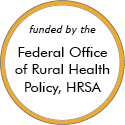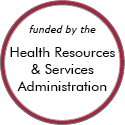Rural Project Examples: Substance use and misuse
Other Project Examples
Camp Mariposa
Updated/reviewed August 2024
- Need: To help children whose family members are struggling with substance misuse.
- Intervention: A year-round program provides mentoring as well as substance use prevention education.
- Results: In 2023, Camp Mariposa served a total of 113 youth in its four rural locations in Indiana, Kentucky, Tennessee, and West Virginia. In a study, 92% of participants reported no use of any substance to get high.
The Pennsylvania Medications for Opioid Use Disorder (PA MOUD) Technical Assistance and Quality Improvement Expansion Project
Added June 2024
- Need: To expand access to medications for opioid use disorder (MOUD) across the state of Pennsylvania.
- Intervention: An initiative formed to provide technical assistance aimed at improving MOUD treatment capacity and quality at healthcare sites across urban and rural Pennsylvania.
- Results: In 2023, 108 providers engaged with the program, treating a total of 5,185 individuals with MOUD. Currently, the program engages partners in 20 Pennsylvania counties – serving rural populations in Crawford, Schuylkill, Susquehanna, Butler, and Cambria counties.
First Day Forward

Added March 2024
- Need: Enhanced support for people with substance use disorders leaving jail and reentering communities in rural northeastern Kentucky.
- Intervention: A reentry program that uses peer support specialists to teach cognitive life skills, obtain essential identification documents, and help people create and follow personalized case plans before and after their release.
- Results: More than 420 people have been served by First Day Forward, with recidivism rates significantly lower among people who successfully completed the program.
Arukah Institute's Living Room Program

Added December 2023
- Need: To address high rates of substance use in Princeton, Illinois and the surrounding area.
- Intervention: The Arukah Institute, a local nonprofit organization providing mental health services, adapted a statewide model to provide support and a safe space for people in need of substance use resources.
- Results: The Living Room program had 1,485 visits in its first year, with 100% of clients served by recovery support specialists.
Richmond Substance Use and Mental Health Mobile Integrated Health Program
Added November 2023
- Need: To reduce the number of overdose deaths in Richmond, Indiana and connect people in need of mental health treatment to community resources.
- Intervention: A mobile integrated healthcare (MIH) program that connects social workers with people who have just experienced a mental health crisis or overdose.
- Results: More than 320 people have been referred to Richmond's MIH programs since June 2022.
School-Based Drug Misuse Prevention Program
Updated/reviewed July 2023
- Need: School-based drug misuse prevention program in Appalachian Ohio, a need triggered by a high school student's overdose death.
- Intervention: Implementation of the HOPE curriculum, an age-appropriate K through 12th grade drug abuse prevention program.
- Results: No further drug overdose deaths after curriculum initiated.
MIST: Mothers and Infants Sober Together

Updated/reviewed May 2023
- Need: To address the needs of pregnant women who are using substances and infants born into drug-positive families.
- Intervention: The Mothers and Infants Sober Together (MIST) program assisted mothers who used substances get treatment and provide a safe, drug-free home for themselves and their newborn.
- Results: MIST has helped mothers find treatment and education and has helped children grow up in safe and healthy homes.
Addiction Recovery Mobile Outreach Team (ARMOT)

Updated/reviewed January 2023
- Need: To reduce the number of overdoses and overdose-related deaths from opioids in rural Pennsylvania.
- Intervention: ARMOT provides 1) case management and recovery support services to individuals with substance use disorders and 2) education and support to rural hospital staff, patients, and their loved ones.
- Results: Since 2015, ARMOT has received over 2,956 referrals.
ASPIN's Certified Recovery Specialist Program


Updated/reviewed September 2022
- Need: Improved approach in addressing the behavioral health and primary care disparities of Indiana's rural counties.
- Intervention: A network was established that trained community health workers (CHWs) to be certified health insurance enrollment navigators and provide mental health services.
- Results: This year, ASPIN trained 230 CHWs, cross-trained 70 behavioral health case managers as CHWs, and 35 individuals in the Indiana Navigator Pre-certification Education.
Isanti County SafeCab Program
Updated/reviewed August 2022
- Need: To reduce the number of deaths and injuries caused by drunk driving in Isanti County.
- Intervention: The SafeCab program provides alternative transportation home for bar patrons who would otherwise drive impaired.
- Results: The program is credited with a significant decrease in DUI (Driving Under the Influence) arrests and the lower average corresponding BAC (Blood Alcohol Content) levels in Isanti County.
For examples from other sources, see:
